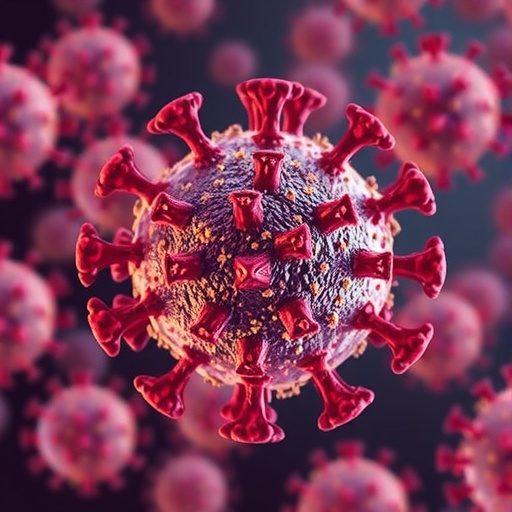In the rapidly evolving landscape of immunotherapy and cellular signaling, manipulating receptor dynamics on cell surfaces stands as a transformative approach to enhance immune responses. Recent breakthroughs have capitalized on the concept of antigen-induced receptor clustering, which serves as a pivotal trigger for cell signaling cascades. These clusters ordinarily form when receptors such as T cell receptors (TCRs) or Fc receptors encounter antigens, initiating downstream immune activation. However, a persistent challenge in harnessing this mechanism therapeutically lies in the naturally limited density of many clinically relevant antigens, especially those associated with tumors. Tumor-associated antigens often fail to cluster receptors sufficiently, resulting in suboptimal immune targeting and responses.
Addressing this fundamental limitation, a pioneering study by Li, Men, Wang, and colleagues, published in Nature in 2025, introduces an innovative strategy to amplify receptor clustering via proximity labeling technologies. This method, originally designed to map protein-protein interactions by biotinylating spatially proximal proteins, has been ingeniously repurposed here to enable synthetic antigen clustering directly on living cell surfaces. By leveraging proximity labeling, the team succeeded in generating dense, covalent assemblies of fluorescein-labeled probes near target antigens, thereby artificially enhancing the local antigen density and the ensuing receptor activation.
The core of this technology revolves around in vivo proximity labeling regulated by external noninvasive stimuli—specifically, red light or ultrasound. These triggers activate catalytic moieties localized at the antigen sites, promoting covalent tagging of fluorescein molecules in a tightly controlled manner. The resulting high-density fluorescein clusters act as surrogate antigens, which then engage with bispecific T cell engagers engineered to bind fluorescein, effectively amplifying T cell receptor clustering. This synergistic effect significantly boosts T cell activation and targeted cytotoxicity, overcoming the inherent limitations posed by low antigen density.
One of the most remarkable features of this approach is its precision and versatility across different tumor microenvironments. Using various syngeneic mouse tumor models, the researchers demonstrated potent, localized immune activation that led to rapid tumor regression while sparing adjacent healthy tissues. The spatial selectivity of proximity labeling means that therapeutic clusters can be generated only where desired, minimizing off-target effects and systemic toxicity. This precision engineering of immune synapses heralds a new era in cancer immunotherapy strategies, particularly for solid tumors traditionally refractory to immune checkpoint blockade or CAR T cell treatments.
Furthermore, the immune cascade set in motion by these synthetic antigen clusters extends beyond immediate tumor lysis. Efficient destruction of tumor cells liberated neoantigens and promoted epitope spreading—a process wherein the immune system broadens its recognition to multiple tumor epitopes, including distal untreated lesions. This systemic immunity manifests as abscopal effects, a phenomenon seldom achieved reliably in clinical settings, making this technology a potential game-changer for metastatic cancer therapy.
In addition to immediate cytotoxicity, the team’s findings reveal that proximity labeling-induced antigen amplification can establish durable immune memory. Mice that experienced complete tumor eradication resisted subsequent tumor rechallenges without further intervention, implying a long-lasting, vaccine-like effect instigated by this synthetic clustering mechanism. This facet underscores the dual role of this technology: not only as an acute therapeutic agent but also as a platform for sustained immunological vigilance against cancer recurrence.
Technically, the system harnesses catalyst-enzyme conjugates localized to antigen sites that, upon external stimulus, activate reactive intermediates to crosslink fluorescein molecules. This chemistry ensures stable, covalent assemblies resistant to enzymatic degradation or diffusion, preserving the antigenic clusters during immune synapse formation. By adapting proximity labeling—a tool primarily used for proteomic mapping—into a therapeutic modality, the work represents an elegant convergence of chemical biology and immunoengineering.
The translation of this methodology from bench to bedside holds enormous promise. Noninvasive activation by red light or ultrasound can be tailored for individual patients, potentially integrating smoothly with clinical workflows. Because the proximity-labeling probes and catalytic systems can be modularly designed for different antigens and receptor-ligand pairs, the platform portends wide applicability beyond T cell receptors, including Fc receptors and possibly other cell types involved in immune regulation.
Despite these advances, challenges remain to be addressed, including optimizing the pharmacokinetics and delivery of proximity labeling components into solid tumor sites, ensuring minimal immunogenicity of synthetic probes, and demonstrating the scalability of this technology in diverse human cancers. Nonetheless, the foundational concepts validated here provide a robust framework for future clinical translation. By engineering synthetic antigen clusters with unparalleled spatial and temporal resolution, this proximity labeling strategy fundamentally redefines how antigen density and receptor clustering can be modulated therapeutically.
In summary, this breakthrough illuminates a new frontier in immunotherapy, wherein chemical proximity labeling transcends traditional biological constraints to supercharge antigen-induced receptor clustering and immune activation. By orchestrating precise, dense assemblies of synthetic antigens directly on tumor cells, the approach amplifies immune engagement and establishes systemic antitumor immunity with immunologic memory. This technology not only exemplifies the power of noninvasive control modalities such as light and ultrasound but also reimagines the role of synthetic biology in shaping immune landscapes. As the field advances, such strategies are poised to revolutionize the therapeutic manipulation of immune receptors, unlocking new potentials in the fight against cancer and beyond.
—
Subject of Research: Antigen-induced receptor clustering and amplification of immune responses via proximity labeling technology
Article Title: Amplifying antigen-induced cellular responses with proximity labelling
Article References:
Li, S., Men, Y., Wang, Z. et al. Amplifying antigen-induced cellular responses with proximity labelling. Nature (2025). https://doi.org/10.1038/s41586-025-09518-6
Image Credits: AI Generated
Tags: antigen-induced receptor clusteringcellular signaling cascadescovalent assembly of probesimmune activation strategiesimmune response enhancementimmunotherapy breakthroughsprotein-protein interactions mappingproximity labeling technologyreceptor dynamics manipulationsynthetic antigen clustering methodstherapeutic challenges in immunotherapytumor-associated antigens targeting






